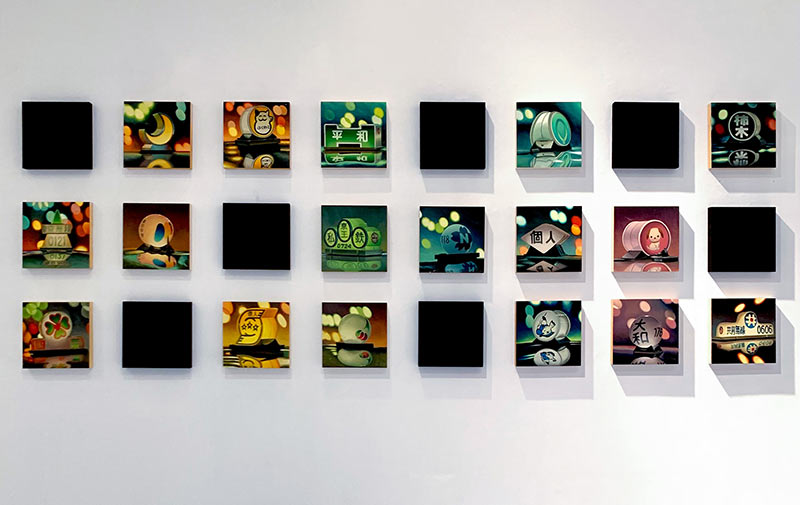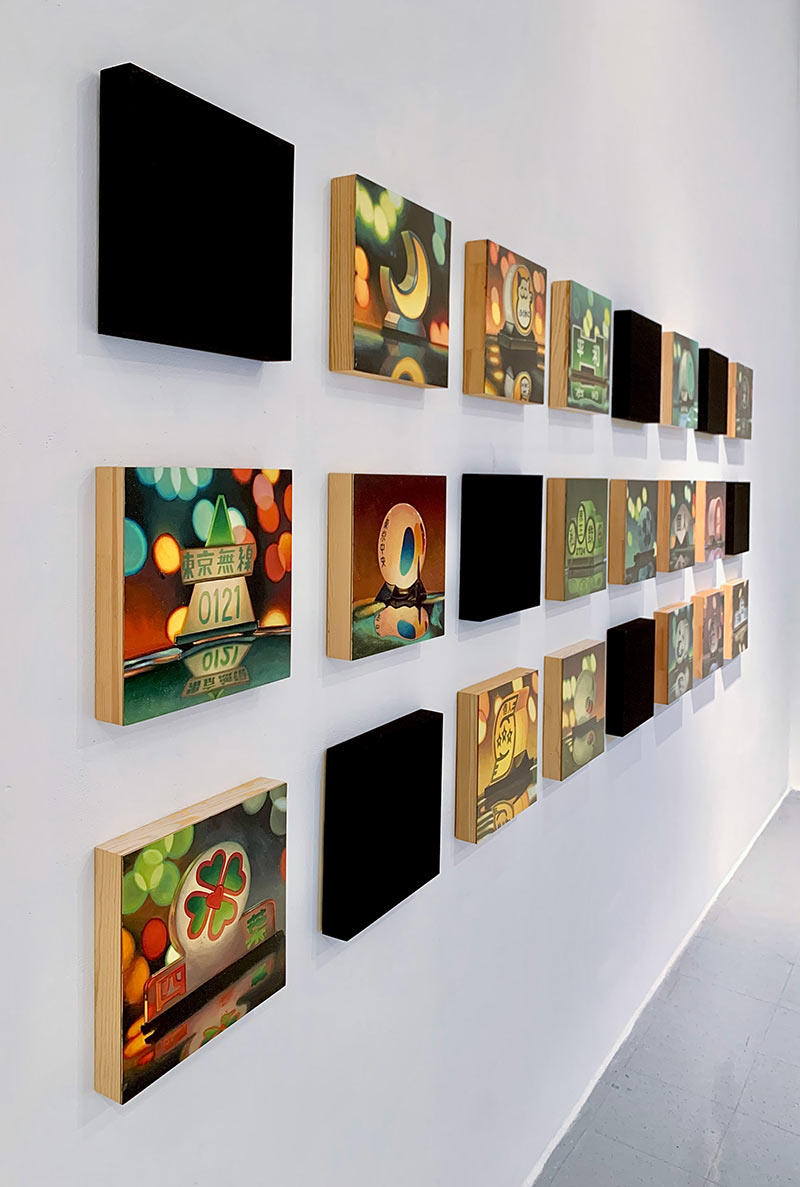Artist Angel Duran reinterprets the Tokyo Taxi series (1986-2011) through the medium of oil painting
Author: Distil Ennui | Post Date: 01-07-2023
In January of 2022 an artist named Angel Duran, a painter based in New Jersey wrote to me....
" Greetings. I received my BFA from Mason Gross School of the Arts in 2020. During my time at school, I came across the photographs you took of Tokyo taxi signs and became instantly enamoured. Not only because of their beauty, but also because of how your process related to my own method of working. I even purchased your 'Tokyo Taxi' book.
Fundamentally, my works serve as an exploration of the relationship between painting and photography. Thematically, they inquire into the role urbanization plays in social fragmentation and the disintegration of human interactions. By often depicting isolated figures roaming through empty and artificially-lit cityscapes, my aim is to highlight how—instead of forming intrapersonal relationships—metropolitan areas can help foster the feeling of isolation; But also, my hope is to form a communal experience built upon our shared moments of isolation.
Why am I telling you this? Well, even though I received my BFA in 2020, my thesis show isn't being held until June of this year. And for my pieces, I planned on making a series of paintings inspired by your photography. My current plan is to construct a painting that's 3ft x 18ft in size, composed of 54 individual 1ft x 1ft wood panels. Each wood panel would contain a different taxi sign. Some yours, some imagined.
Not only was I hoping for your permission, but I was also wondering if you possibly had more photos available through one of your PDF portfolios. My goal is not to profit off of your work (I've actually never sold a painting before), rather my goal is to form a dialogue between your photography and my paintings and anything would help.
I hope this doesn't offend you in any way, as that was not my intention, I'm simply an admirer. Thank you for your time and consideration."
Well he did not cause any offence as it was a well written request with a clear outcome in mind, so I supported with permission and imagery. The works were exhibited as planned which you can see in the above & below images. The subsequent thesis 'Urbanization and Social Isolation Expressed thru Japanese Taxi Signs' is noted below, providing an insight into the thoughts and process involved.
It is always a good sign when young artists understand the need to reach out ahead of using others artists work, this was a thought provoking dialogue where the out coming paintings were sensitive and well executed. I look forward to seeing where this painter goes next. You can find these works on Angel's website.


'Ebisu Taxi' dated 1988. from the 'Tokyo Taxi' series by Alexander J Hamilton.

Urbanization and Social Isolation Expressed thru Japanese Taxi Signs
Fundamentally, my works serve as an exploration of the relationship between painting and photography. As a painter, I've always been interested in how photographs can be used to capture fleeting moments of time and how paintings can expand upon those moments, imbuing them with emotion and meaning. Thematically, my works inquire into the role urbanization plays in social fragmentation and the disintegration of human interactions. By often depicting isolated figures roaming through empty and artificially-lit cityscapes, my goal is to highlight how, instead of forming intrapersonal relationships, metropolitan areas can help foster feelings of isolation.
But more importantly, I aim to form a communal experience built upon our shared moments of isolation. I believe that art can bring people together by highlighting our common experiences and helping us to better understand one another. In exploring the relationship between painting and photography and investigating the impact of urbanization on human connections, I hope to create art that speaks to our shared experiences and encourages us to connect with one another.
CHAPTER I
Most recently, I found inspiration in an unexpected place: Japanese taxi signs. Although I'm Dominican and grew up in the United States, I've always been influenced by Japanese culture. From watching anime like Naruto, Dragon Ball Z, and Akira to playing Yu-gi-oh, Japanese culture has played a significant role in shaping my worldview. So when I came across photos of Japanese taxi signs while scrolling through Pinterest, I was immediately intrigued.
It’s this interest in Japanese culture that led me to buy the book "Tokyo Taxi" by Alexander James. The book is not only a collection of these photographs, but also a detailed exploration of James' process of capturing the flow of taxis in Akasaka — a central business district in Tokyo — and I was instantly captivated by his method. Over the course of 26 years and 12 trips to Japan, James spent his evenings taking photos of the shining roof signs (Taxi Times, para. 5). As James explains, “the majority of the research and planning for each shoot was undertaken late at night in the sushi and noodle bars buried deep in the backstreets of the Akasaka neighbourhood” (James 14), after which he would pedal for miles, furiously snapping photos of the rarer signs of independent driver-owned taxis, known as kojin taxis, and smaller cab companies that only operated a few cars. And although it was sure to be a lot of work, the results were more than worth it: “Tokyo’s transformation at night is simply magical, and full of unexposed film, the possibilities seem(ed) endless” (James 18).
But most importantly, I connected with James' process as it was similar to mine. I often found myself in my studio late at night, and since my studio was the only one with a window, I was gifted with a clear view of the busy New Brunswick streets. I found myself almost entranced by the way the light danced off the buildings and the roads, creating a completely different atmosphere than during the day. The hustle and bustle of the daytime hours were replaced by an almost eerie stillness, broken only by the occasional car passing by or the sound of footsteps echoing off the pavement.
This process became almost ritualistic for me; as soon as the sun went down, I would make my way to my studio and begin my work. I found that I was most productive during these nighttime hours, and I relished in the sense of solitude that came with being the only person awake and working in the building. In many ways, it was a meditative experience, allowing me to fully immerse myself in my work without any distractions or interruptions.
As I delved deeper into James' book, I couldn't help but draw parallels between his experience in Tokyo and my own in New Brunswick. While the two cities were vastly different in many ways, there was a similar sense of transformation that occurred once the sun went down. The streets that were crowded and chaotic during the day became almost empty at night, and the once-familiar landscape took on a completely different character. It was in these moments that I felt most connected to James and his work, as we both found beauty in the quiet moments that many others overlooked.
Reading James' book made me want to go to Japan even more, but I was dismayed to find that many of these signs no longer existed. When he started the project, there were approximately 1,024 cab companies. Now, James estimates there are only about 70 (Taxi Times, para. 6). Increasingly, kojin taxis and family businesses are being absorbed into larger cab corporations — or being overtaken by ride-sharing apps such as Hailo or JapanTaxi — causing the number of diverse taxi signs to slowly disappear from roadways. “Many of these taxis don’t exist anymore,” James says. “All of these unique signs are now being homogenized.” (Taxi Times, para. 6)
Ultimately, I found that these signs, James' process, and their subsequent disappearance perfectly encompassed the themes I was trying to explore through my art. In this way, these unique taxi signs became the perfect symbols to represent how individuality and diversity are elements that are increasingly disappearing in our urban environments and contributing to our collective sense of isolation.
CHAPTER II
In building upon the themes, it’s important to first highlight the effect technology and urbanization have had on our social interactions. There’s no doubt that the advancement of technology has profoundly transformed the way we individuals and our communities across the globe interact, allowing us to communicate with unprecedented ease and immediacy. Through a myriad of platforms such as social media, messaging applications, and video conferencing, people from diverse geographic locations can now effortlessly connect — bridging the gaps of distance and promoting cross-cultural communication. As a result, the barriers that once hindered global communication have been significantly reduced, facilitating unprecedented opportunities for worldwide collaboration and cooperation.
And yet, according to surveys by the U.S. Census Bureau, around 75% of adults in the U.S. report feeling lonely regularly — the highest rate it’s ever been (Fiorillo, para. 4). And while many other factors are to blame, the proliferation of social media, messaging and urbanization have given rise to a paradoxical situation whereby the methods by which people are interconnected has caused them to experience a greater sense of isolation and disconnection in their day-to-day lives.
The convenience of online interaction has made it increasingly tempting for individuals to opt for virtual engagement, as opposed to having in-person social interactions. One can argue that this shift from social to para-social interactions is what has led to the loss of face-to-face communication skills for many. These para-social interactions, however, cannot fully replace the richness and complexity of nonverbal cues, tone, and context that are integral to fully understanding the nuances of a conversation (Nierenberg, para. 20). Consequently, the heightened levels of anxiety they may experience when interacting in-person — due to the lack of practice in engaging in such interactions resulting from their over-reliance on technology — further causes them to retreat behind a screen.
While technology has undoubtedly played a significant role in the rise of social isolation, it is important to also consider how environmental factors, such as urbanization and community dynamics, have also contributed to these feelings. Cities are often seen as hubs of social and cultural activity, hosting diverse communities and recreational opportunities that foster social connections and interactions. For many, living in a city can provide an avenue for meeting new people, experiencing different cultures, and cultivating a sense of belonging. However, for some individuals, cities can be perceived as catalysts for disconnection and loneliness: with the fast pace and complexities of urban life–coupled with high levels of anonymity and social distance–making it difficult for them to form deep and meaningful connections with others or to feel a sense of belonging within the community.
Furthermore, certain features of urban design and infrastructure can also serve as contributing factors. For example, the prevalence of high-rise buildings and gated communities can create physical barriers and limit opportunities for spontaneous interaction with neighbours and strangers. According to Dr. Shima Beigi, a research fellow at Deakin University in Australia, “the way cities are designed is having a negative impact on social interaction [because] modern urban planning often prioritizes efficiency and practicality over creating spaces that foster human connections.” Similarly, she also points to the negative effects that the use of cars and other forms of private transportation can create for the wider community: “many city streets have become car-dominated, discouraging walking and other forms of active transport that can facilitate chance encounters and social connections” ("Urban planning" para. 3).
CHAPTER III
In many ways, the experience of taking a taxi ride can be similar to the experience of using technology to communicate and interact with others. While technology can certainly connect us to people from all over the world, it can also feel like a solitary and disconnected experience, particularly if we are using it as a substitute for in-person social interaction. Just as using technology to communicate with others can feel transactional and devoid of social connection, a taxi ride can sometimes feel similarly isolated and disconnected, even though we may be physically surrounded by other people.
But how can a vehicle whose sole purpose is to connect people paradoxically have this effect? Well firstly, taxis are often small and enclosed spaces and when shared with other riders can feel cramped and uncomfortable — which makes it difficult to interact with others or engage in meaningful conversation. Passengers may feel awkward or self-conscious about striking up a conversation with a stranger in such a confined space, and may prefer to simply remain silent and keep to themselves. Ride-sharing apps such as Uber and Lyft have even gone so far as to implement a “quiet-mode” feature so that drivers are aware that passengers aren’t interested in conversing.
Secondly, the dynamic between passengers and taxi drivers can also contribute to a sense of disconnection and isolation: While passengers can sometimes be friendly and engaging, they are also there to get to a specific destination and may view the driver as someone who’s simply there to perform a specific job and may not have the time or inclination to engage in lengthy conversations with them. This can make the drivers feel like they are simply there to shuttle people from one place to another, rather than engaging in meaningful social interactions. Or conversely, taxi drivers may not have the time or inclination to engage in lengthy conversations with passengers.
Finally, the very fact that taxi rides are often brief and focused on a specific destination can also contribute to a sense of disconnection and isolation. Unlike other forms of transportation, such as buses or trains, there is often little opportunity for passengers to interact with others or explore the surrounding environment during a taxi ride. This can make the experience feel like a transactional one, rather than a social or community-building one.
All of this is not to say that all taxi rides are a negative experience, much like not all virtual interactions are bad. Despite the small and enclosed space, taxi rides can provide opportunities for conversation and connection with both the driver and other passengers. In fact, Alexander James makes frequent mention of the engaging and meaningful conversations he had with taxi drivers while venturing on the streets of Tokyo. Moreover, taxi drivers can provide a unique and valuable perspective on the local area, offering tips and insights on the best places to eat, visit, and explore, which can help passengers feel more connected to their surroundings and promote a sense of community and belonging. And while brief, these rides can still offer opportunities to experience and appreciate the local environment in a different way. Passengers can take in the sights and sounds of the city or neighbourhood, and even discover new places that they may want to return to and explore further — serving as a mini adventure that contributes to a sense of curiosity and exploration. However, it’s becoming increasingly clear that the former is becoming the norm.
CONCLUSION
All of which brings me back to my taxi sign paintings. So far, I have managed to complete 24 of them. Because of this, they are arranged in three rows of eight; however, this configuration is open to further evolution as I continue to incorporate additional pieces. On a strictly visual level, the brush strokes and colour palettes I employ are carefully selected to attract the viewer purely with their aesthetic beauty. I arrange the pieces in a gradient pattern, which I then deliberately interrupt with solid black squares. It’s the inclusion of these solid black squares that serves the critical purpose of allowing the piece to not only breathe, but to also invite the viewer to contemplate its deeper meaning.
The story behind the taxi signs' disappearance adds an additional layer of complexity to the artwork and by explaining how the majority of the taxi signs no longer exist, I am able to convey a sense of nostalgia and loss. The black squares, in turn, can then be interpreted in one of two ways: as a symbolic representation of the taxi signs that have been bought out or, conversely, as a memorial to the remaining signs. This duality invites the viewer to reflect on the transient nature of urban landscapes and the impact economic forces have on their evolution. Thus, these taxi sign paintings can be seen not merely as visual artefacts, but rather as a powerful commentary on the cultural and social dynamics that urban environments have on us and how we navigate within them — both physically and technologically.
I hope you found this journal entry informative, please stay connected.
Join the mailing list.. Register
Telegram Channel.. DistilEnnui
Instagram.. AJHamilton.Artist
Twitter.. DistilEnnui
Citations......
James, Alexander. Tokyo Taxi. Merrell Publishers, 20 Mar. 2012.
"Tokyo’s Vibrant, Adorable Taxi Signs are Disappearing." Taxi Times, 2 Feb. 2023, https://www.taxi-times.com/tokyos-vibrant-adorable-taxi-signs-are-disappearing/
"The Guardian." The Guardian, 20 Nov. 2019, https://www.theguardian.com/cities/2019/nov/20/urban-planning-is-reducing-social-interaction-warns-academic.
Hill, Angie Schmitt. "Are You Lonely? It's Not You, It's the Way We've Built Our Nation." Streetsblog USA, 27 Jan. 2023, https://usa.streetsblog.org/2023/01/27/are-you-lonely-its-not-you-its-the-way-weve-built-our-nation/.
Kuhn, Robert Lawrence. "Cities Designed for Loneliness." Mad in America, 25 Feb. 2019, https://www.madinamerica.com/2019/02/cities-designed-loneliness/.
"The cities we create lead to isolation and loneliness." University of Sydney News, 2 Feb. 2023, https://www.sydney.edu.au/news-opinion/news/2023/02/02/the-cities-we-create-lead-to-isolation-and-loneliness.html.
Fiorillo, Victoria. "Why Americans are lonelier — and it's affecting our health." PBS NewsHour, 4 Mar. 2019, https://www.pbs.org/newshour/show/why-americans-are-lonelier-and-its-effects-on-our-health.
Nierenberg, Cari. "The simple but crucial way to sharpen your brain and improve your well-being." CNN, 7 June 2021, https://www.cnn.com/2021/06/07/health/face-to-face-brain-wellness-scn/index.html.